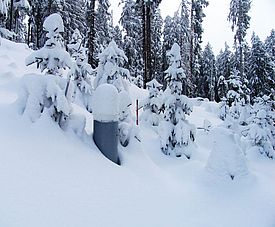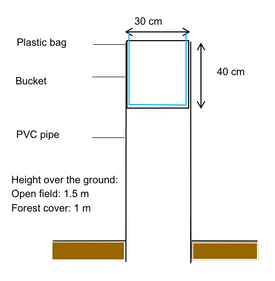Agricultural activities and combustion processes release pollutants such as ammonia (NH3), nitrogen dioxide (NO2) and sulphur dioxide (SO2) in the atmosphere. These substances enter the forest ecosystem as gas or particles, or dissolved in precipitation in form of ammonium (NH4+), nitrate (NO3-) and sulphate (SO42-). They can accelerate the acidification of forest soil.
In addition, nitrogen compounds have a fertilizing effect, which can promote tree growth. However, in large quantities, nitrogen can disrupt the nutrient balance of the trees.
During the winter season, the snow collectors replace the rain collectors (3) on LWF sites with heavy snowfall in the Alpine foothills and Alps. At the end of the 2- to 4-week-sampling period (depending on the site and its accessibility), snow bags are replaced by empty clean bags. The snow bags containing the precipitation samples are either transported to the WSL for further processing or they are weighed in the field and a subsample is sent to the WSL for chemical analyses.
Objectives of the measurements
In combination with rain collectors (3) and stemflow collectors (10), snow collectors allow the following:
- to quantify atmospheric deposition, i.e., the input of sulphur, nitrogen and other pollutants and nutrients from the air into the forest ecosystem;
- to record precipitation as well as interception of snow and rain by the canopy.

